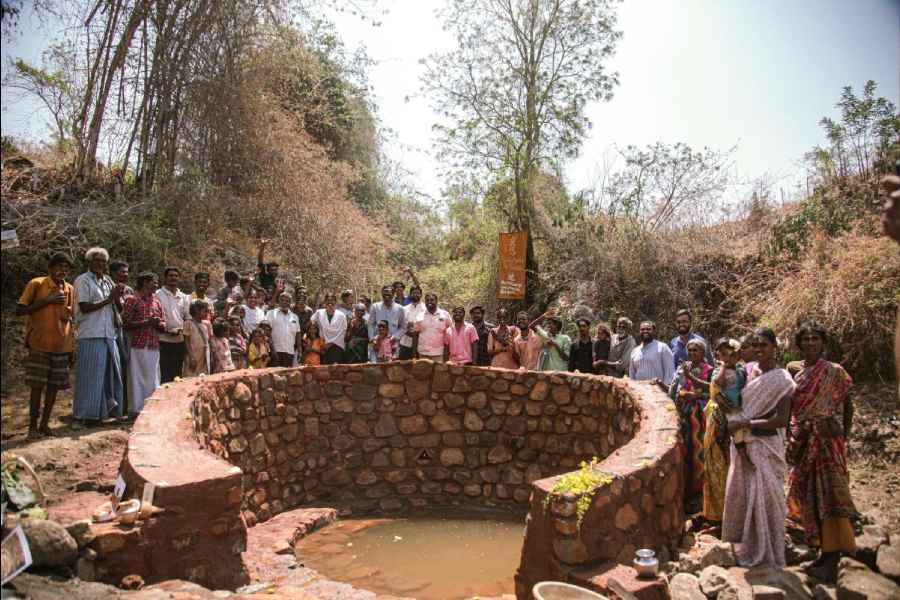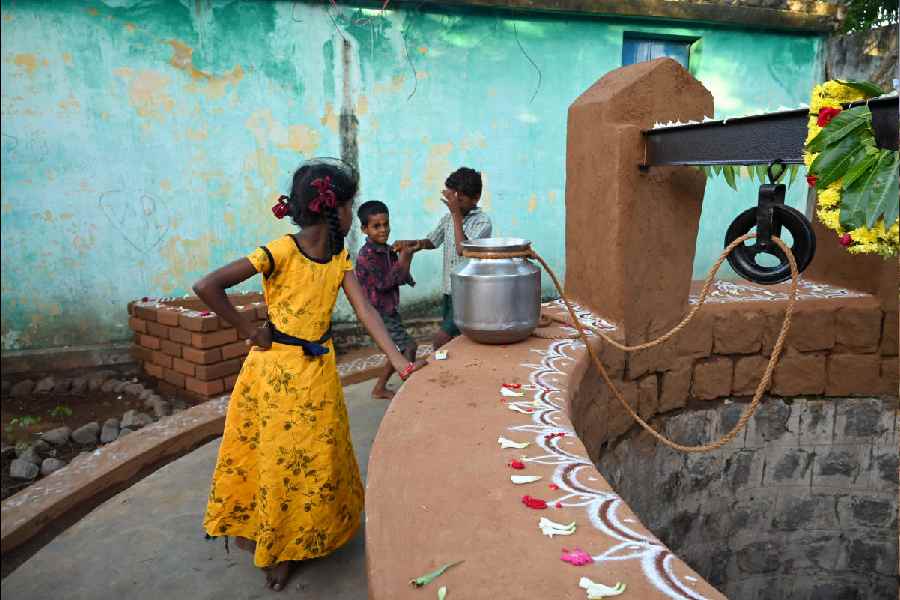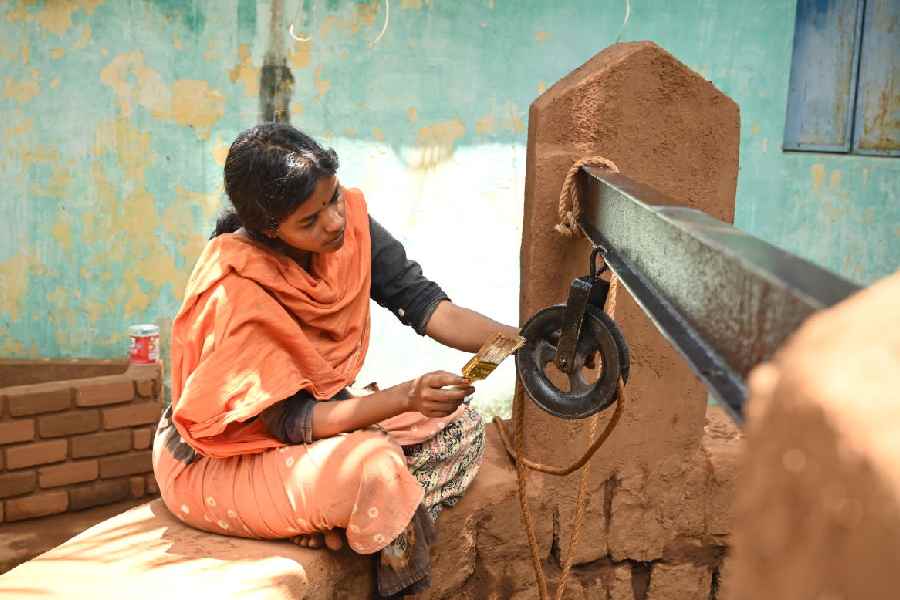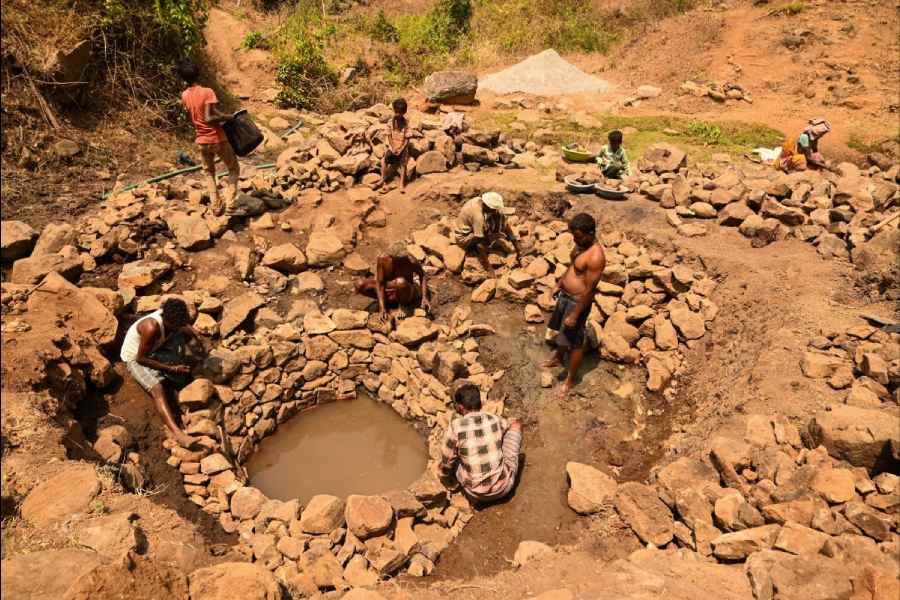On the outskirts of Nayakanur village, in Krishnagiri district of Tamil Nadu, there was a round concrete structure filled with mud and debris. It was a dead well. After Independence, a slew of wells were dug across Tamil Nadu, but many, like this one, turned defunct when access to it came to be controlled by caste considerations. It did not matter that this was a water-scarce region.
Nayakanur is home to upper castes as well as Dalits. Sixty years ago, every villager drew water from the well here. But the story goes that during a municipal election when the Dalits refused to vote for the upper caste candidate running for councillor, he filled the well with the remains of a pig. “In villages, there is this belief that if animal remains are dumped in a well, it cannot be used any further,” Bharathy Gopal, a volunteer with the Cuckoo Movement, tells The Telegraph.
The Cuckoo Movement is a group that used to work primarily with village children in Tamil Nadu and has now diversified into reviving wells across the state. Bharathy, who works with an IT company, is a Cuckoo volunteer. Manjari, who goes by a single name, is another volunteer and an architect.

The Cuckoo movement took upon the task of deepening the well at Agnibavi village and also and expanding its diameter. Photo courtesy: The Cuckoo Collective
Manjari speaks to The Telegraph over the phone in between her travels. One day she is busy in Puliyanoor meeting the district forest officer. The very next day she is in Solaganai. In Nayakanur, the first village she visited — the village with the dead well — she met a 55-year-old woman who wakes up every day at 5am to walk seven kilometres to fetch water. She met a pregnant teenager doing the same. The examples pour out of Manjari. She continues, “Before long we spoke to the local authorities and started working on reviving the well.” Between 2020 and 2024, the group revived 15 wells in different parts of Tamil Nadu.
From identification to revival, working on wells is not an easy process. It takes anything between six weeks and three months to revive a single well. The effort includes community engagement in addition to intensive physical labour.

The Cuckoo movement took upon the task of deepening the well at Agnibavi village and also and expanding its diameter. Photo courtesy: The Cuckoo Collective
Till November this year, the Cuckoos have revived five wells in tribal settlements in mountainous regions. “The challenge in working in such inaccessible terrain is that the material costs and the transportation costs go through the roof,” says Bharathy. Manjari agrees, “In Agnibhaavi, a remote hilly village in Erode district, we lugged the materials to the site. There were no roads leading to the well.”
Every well is an experience. When the Cuckoos were working to revive the well in Erode, villagers came up to them to say that according to local lore, once upon a time elephants would also drink water from the well. They requested volunteers to create space for elephants to approach the well.
Manjari says, “You will not believe it, but on the eve of the inauguration, an elephant with a calf came and drank water from the well. We saw their footprints.” The Cuckoo team engages closely with the villagers during the well-digging process. Depending on these conversations, in other places they have added a washing stone close to the well or a place for women to relax in.

A well in Puliyanur village; it has been constructed using the mud plastering method. Photo courtesy: The Cuckoo Collective
In Nayakanur they met a 95-year-old master well-digger. He guided their hand.
A year ago, Manjari and her co-workers went to Solaganai village, which used to be the regular haunt of sandalwood smuggler Veerappan. “The government had dug 20 borewells there but all of them went dry and could not be used,” she says. “The villagers had to cross two mountain slopes to get water. There was one well that people had been using but it turned dry in summer. We revived a well in that village located amidst a cluster of mountains,” she adds. At Solaganai, Manjari and her team trekked 12 kilometres to get to the well site.

Manjari, an architect and a Cuckoo volunteer. Photo courtesy: The Cuckoo Collective
More stories tumble out. The rejuvenated wells become a life source for people. At Puliyanoor village in the foothills of the Javadhu Hills, there are about 400 houses, most of them belongingto Scheduled Tribes. The wellhere was dug shortly after the village was established decades ago. Following a feud between thefamilies maintaining the well, it had fallen into disuse and was covered in mud.
Cuckoo volunteers and Manjari set to work and now the well is brimming with water. “There are many springs that are opening up and the water level is high,” says Manjari. A guava tree and a banyan tree guard the rejuvenated well. Children frequent this spot to do their homework. The well walls have been coloured with natural materials such as dye from the Indian hog plum.
But no one should assume that all is smooth sailing. “Almost always, it begins with locals laughing at our efforts. You see, they are so used to not having water in the defunct wells, that they don’t believe that water can be found,” says Manjari. She continues, “We start clearing the debris and keep digging. When we finally reach the water level, their faith turns a corner. That is when they pitch in wholeheartedly and help us complete the job.”
Power equations also come in the way. Volunteers face opposition from mid-level administrative functionaries. “The collectors or the block development officers are supportive as they understand our work, but members of the panchayat and local administration are constantly opposing us,” says Manjari. Once, when the dead well was inside a forest, the forest ranger refused to grant them access.
Over the past many months, Cuckoo volunteers have learned to befriend the youth of the community at the outset and also reach out to village clubs, women, as well as the village panchayat. Manjari is tasked with securing permission from the various government departments; she also scouts around for funds. “We generally employ local people for the work, but we provide the materials and tools,” she explains.
As the Cuckoo Movement gains momentum, it is taking up more projects. Volunteers are not just reviving old wells, but digging new ones too.
In another part of the mountainous village of Solaganai, volunteers found locals digging through sand to find water. “We spoke to forest officials and gram sabha members. Four borewells had been sunk in the region but none had water. And yet we knew there were pockets of water in that region,” she says. A plan was drawn up to dig a well that will cater to the water needs of three adjoining mountainous villages. This will be the first well that the Cuckoos will dig from scratch.
Manjari says, “At any given point of time, we are a five-member team working on wells. Whoever has the time and the bandwidth joins in.” Almost always in tow is a group of students documenting the entire process.
After all, elephants might remember, but human memory is another thing.











